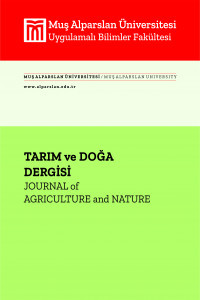Thaumetopoea pityocampa Denis & Schiffermüller, 1775 (Lepidoptera: Notodontidae) Biyolojisi ve Ekolojik Etkileri
Bu çalışmada, Çam kese tırtılı olarak bilinen Thaumetopoea pityocampa (Lepidoptera:Notodontidae) Denis& Schiffermüller, 1775 birçok bitki türü üzerinde yaptığı etki araştırılmış ve ilgili bitki türlerinde önemli ölçüde zarar meydana getirdiği belirlenmiştir. T. pityocampa türü döngüsel bir şekilde 6-8 yıllık sürelerde, ormanlık alanlarda son dört yıl üst üste başta karaçam ve kızılçam ağacı türlerinde toplu bir halde bulunarak yüksek düzeyde zarara neden olduğu belirlenmiştir. Özellikle abiyotik faktörlerin canlının popülasyonunun artışında oldukça önemli etkilere neden olduğu, son yıllarda artan iklimsel değişimlerin etkisinin büyük olduğu görülmektedir. Zararlı olan bu türe karşı biyolojik mücadele yöntemlerinin etkili olabileceği; yöreye ait olan kuş türlerinin ve bazı parazitoitlerin salınımının sağlanarak zararlı popülasyonunu dengeleyici önemli bir mücadele yöntemi olarak kullanılması önerilmektedir. Doğu Anadolu bölgesinde birçok ormanlık alanda belirli yıllarda meydana gelen üreticilerin yoğun bir şekilde başvurduğu kimyasal mücadele yöntemlerinin sonraki yıllarda zararlıyı daha dirençli hale getirdiği, birçok canlı türünün ölümüne yol açtığı (toplu arı ve kuş ölümleri vb.) ve ticari arıcılık faaliyetleriyle birlikte diğer kültür bitkilerin kalite kaybına neden olduğu aktarılmaktadır.
Anahtar Kelimeler:
Çam kese tırtılı, Thaumetopoea pityocampa, Zarar, Biyolojik mücadele
Thaumetopoea pityocampa Denis & Schiffermüller, 1775 (Lepidoptera: Notodontidae) Biology and Ecological Effects
In this study, the effect of Thaumetopoea pityocampa (Lepidoptera:Notodontidae) Denis & Schiffermüller, 1775 known as the pine processionary, on many plant species was investigated and it was determined that it caused significant damage to the related plant species. It has been determined that T. pityocampa species were found in a cyclical manner for 6-8 years, and in the last four years in a row, in the region, mainly in pine tree species, and in some fruit trees and products grown in gardens, causing a high level of damage. It is seen that especially abiotic factors cause very important effects on the increase in the population of the living thing, and the effect of increasing climatic changes in recent years is great. Biological control methods can be effective against this harmful species; it is suggested to be used as an important control method to balance the pest population by ensuring the release of bird species and some parasitoids belonging to the region. It has been determined that the chemical control methods used extensively by the agricultural producers in the region make the pest more resistant in the following years, cause the death of many living species (mass bee and bird deaths, etc.), and cause loss of quality of other cultivated plants together with commercial beekeeping activities.
___
- Androic, M. (1957). The pine processionary (Thaumetopoea pityocampa): A biological and ecological study. Glasmkza Sumski Pokuse, 13, 351-359.
- Arnaldo, P. S., & Torres, L. M. (2006). Effect of different hosts on Thaumetopoea pityocampa populations in northeast Portugal. Phytoparasitica, 34(5), 523-530. https://doi.org/10.1007/BF02981209
- Bergand, J. M. (1978). La chenille processionnaire du pin (Thaumetopoea pityocampa Schiff) et l’homme. Thése no. 41, Université de Bordeaux.
- Biliotti, E. (1958). Les parasites et prédateurs de Thaumetopoea pityocampa SCHIFF. (Lepidoptera). Entomophaga, 3, 23-24. https://doi.org/10.1007/BF02372196
- Biliotti, E., Demolin, G, & Du Merle, P. (1965). Parasitisme de la processionaire du pin par Villa quinquefasciata Wied. apud Meig. (Diptère, Bombyliidae). Importance du comportement de ponte du parasite. Annales des Epiphyties, 16, 279-288.
- Carus, S. (2004). Impact of defoliation by the pine processionary moth (Thaumetopoea pityocampa) on radial, height and volume growth of calabrian pine (Pinus brutia) trees in Turkey. Phytoparasitica, 32(5), 459-469. https://doi.org/10.1007/BF02980440
- EPPO (European and Mediterranean Plant Protection Organization). (2004). Diagnostic protocols for regulated pests: Tomato spotted wilt tospovirus, Impatiens necrotic spot tospovirus and Watermelon silver mottle tospovirus. EPPO Bulletin, 34(2), 271-279.
- Jacquet, J. S., Bosc, A., O’Grady, P., & Jactel, H. (2013). Pine growth response to processionary moth defoliation across a 40-year chronosequence. Forest Ecology and Management, 293, 29-38. https://doi.org/10.1016/j.foreco.2012.12.003
- Kanat, M., Sivrikaya, F., & Serez, M. (2002). Research on damage of pine processionary moth (Thaumetopoea pityocampa Schiff.) on Pinus brutia Ten. trees, and the effect of tending activities on the diameter increment of Calabrian pine in Kahramanmaraş. Proceedings of the Pine Processionary Moth Symposium, Kahramanmaraş, Turkey, pp. 44-51.
- Kerdelhué, C., Zane, L., Simonato, M., Salvato, P., Rousselet, J., Roques, A., & Battisti, A. (2009). Quaternary history and contemporary patterns in a currently expanding species. BMC Ecology and Evolution, 9, 220. https://doi.org/10.1186/1471-2148-9-220
- Masutti, L., & Battisti, A. (1990). Thaumetopoea pityocampa (Den. & Schiff.) in Italy Bionomics and perspectives of integrated control. Journal of Applied Entomology, 110(1-5), 229-234. https://doi.org/10.1111/j.1439-0418.1990.tb00117.x
- Mirchev, P. B., Tsankov, G., Avci, M., & Matova, M. (2007). Study of some aspects of ecology of pine processionary moth, Thaumetopoea pityocampa (Den. & Schiffe.) (Lep., Thaumetopoeidae) and its egg parasitoids in Turkey. Silva Balcanica, 8(1), 66-78.
- Pimentel, C. T., Calvão, T., Santos, M., Ferreira, C., Neves, M., Nilsson, J.-Å. (2006). Establishment and expansion of a Thaumetopoea pityocampa (Den. & Schiff.) (Lep. Notodontidae), population with a shifted life cycle in a production pine forest, Central-Coastal Portugal. Forest Ecology and Management, 233(1), 108-115. https://doi.org/10.1016/j.foreco.2006.06.005
- Salman, M. H. R., Hellrigl, K., Minerbi, S., & Battisti, A. (2016). Prolonged pupal diapause drives population dynamics of the pine processionary moth (Thaumetopoea pityocampa) in an outbreak expansion area. Forest Ecology and Management, 361, 375-381. https://doi.org/10.1016/j.foreco.2015.11.035
- Zovi, D., Stastny, M., Battisti, A., & Larsson, S. (2008). Ecological costs on local adaptation of an insect herbivore imposed by host plants and enemies. Ecology, 89(5), 1388-1398. https://doi.org/10.1890/07-0883.1
- Başlangıç: 2022
- Yayıncı: Muş Alparslan Üniversitesi
